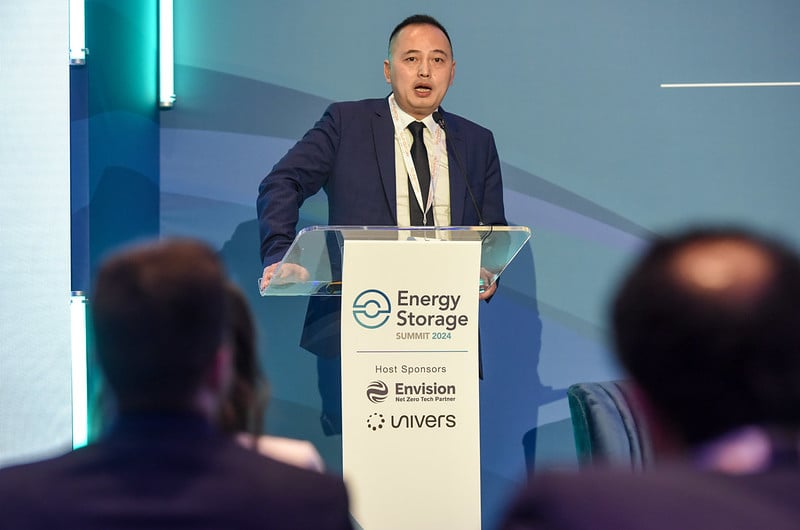
We caught up with James Li, European energy storage director of inverter and BESS provider Sungrow, at the Energy Storage Summit EU 2024.
Li was a speaker on Day 1 of the two-day event put on by our publisher Solar Media in London this week (20 and 21 February).
Enjoy 12 months of exclusive analysis
- Regular insight and analysis of the industry’s biggest developments
- In-depth interviews with the industry’s leading figures
- Annual digital subscription to the PV Tech Power journal
- Discounts on Solar Media’s portfolio of events, in-person and virtual
In this interview conducted on-site, he discusses last year’s challenges, what is happening with battery energy storage system (BESS) prices and the company’s priorities for future technology improvements.
Deployment delays
Last year was clearly a good year for the ESS (energy storage system) division of Sungrow, with the company soaring to the top of the global energy storage deployment leaderboards according to data from Wood Mackenzie, slightly ahead of Fluence and Tesla.
Energy-Storage.news reported on notable projects using Sungrow BESS last year in South Africa, Texas, UK, Israel and Chile. The company launched its latest grid-scale product iteration the PowerTitan 2.0 last year.
But the year was not without its challenges. Li said that originally the company was set to ship 1.3GWh of BESS to Europe and Israel in 2023 but 30% of that was delayed and held in its China headquarters, due to various geopolitical challenges, particularly in the Middle East like the Red Sea shipping attacks and the Israeli-Palestinian conflict.
A BESS cannot simply be warehoused in the way a solar PV module can, as it needs to be kept at a 50% state of charge (SOC) to minimise degradation, so charging solutions need to be found when shipments are held back.
BESS pricing
Alongside those transportation challenges, 2023 also saw the global average price of BESS fall back down from the highs of 2022, and that is expected to fall further this year. That has been driven by the fall in lithium-ion battery cell prices which itself was driven, in large but thought not entirely, by falls in raw material prices (primarily lithium carbonate).
We ask Li what the implications of this fall in BESS price are for a company like Sungrow, as well as the importance of pricing in the energy storage market generally.
“First, we need to be really transparent to the customer, everyone can see the raw material pricing, and we don’t want to take advantage of anyone on pricing. But the main thing is we want to the show the customer our quality and diversity of cell supplier as a system provider,” Li says.
“Before it was all CATL batteries and now with these prices falls we have many qualified cell suppliers that can offer the same warranty. It’s good to have more options, otherwise you’d just get another industry bottleneck.”
Li said that while price is clearly not everything, the influx of new companies into the space means it is becoming more important:
“The price is getting more important for the client side, because the clients are getting more diversified. They aren’t just traditional energy or industrial companies like before, now they are finance companies and even pension funds who are entering the sector because it’s been very profitable in the last few years. Those types of companies are more focused on the financial model so pricing is very important for them.”
Technology improvement priorities for Sungrow
The discussion moves on to the technological improvements to its BESS product that Sungrow is focusing on. Safety is the biggest one, followed by grid compliance and the finally the electro-chemistry of the cells that go into the BESS, Li says.
“We are also trying to set up our own cell manufacturing soon because that is the really key thing to the storage of the energy and the long-term life of the BESS, and controlling quality. Next year we’re hoping to have a production line producing our own lithium-ion battery cells.”
“We’re also looking at sodium-ion battery technology, but the energy density is still very different to lithium-ion and the pricing is also uncertain.”
Energy density is a technical aspect of BESS which has been looked into by Energy-Storage.news recently, with a developer source recently telling us that increasing energy density has potential downsides while EPC firm Burns & McDonnell wrote about it for the most recent edition of Solar Media’ quarterly journal PV Tech Power.
Sungrow’s PowerTitan 2.0 is one of several in the industry to pack 5MWh of energy storage capacity into a 20-foot container.
On the topic, Li says: “Energy density is a key thing for us. The sector is facing more land-constrained sites, but for us a more energy-dense product reduces our supply chain risk by being able to transport more capacity more efficiently.”
“But of course it’s a balance and you need to invest in the cooling and heat dissipation technologies of the BESS alongside that. Our system has also become less noisy while doubling energy-density compared to the first generation.”

